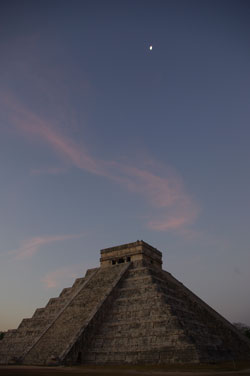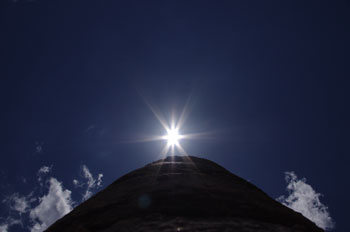Calendar in the Sky
Happy Birthday! Let’s do lunch next month. Only 197 shopping days until Christmas! When is Easter this year? [It’s] time to plant the tomatoes. Only two more weeks of school left! Happy 4th of July!
Calendars are tools that can be used to measure time and record events. They can also be used to plan future events. Cultures all around the world and throughout history have invented a variety of calendars to mark time. Official time is kept here, in the United States, based on the natural cycles of atomic clocks. Our official calendar is also based on the cyclical movements of objects in the sky, as are the majority of calendars kept by other cultures, past and present, including the Maya.
The scientific concept of time is that it steadily moves from the past through the present into the future. To measure it, we often use something that repeats regularly: a heartbeat, ticks of a clock, etc. We simply count the number of cycles that pass from one event to the next.
The basic unit of time recorded in most calendars is a day, the amount of time that it takes the Sun to make a complete trip across the sky (example: from noon to noon). It is not actually the Sun that moves through the sky, but Earth spinning around that makes the Sun, Moon, planets, and stars appear to move from east to west through the sky.

a gibbous Moon seen at dawn over the Castle of Kukulkan at Chichen Itza, Mexico. (Image Credit: Bryan Mendez, UC Berkeley)
The Moon cycles through a series of phases: New, Crescent, Quarter, Gibbous, Full, Gibbous, Quarter, Crescent, and New again. It takes an average of 29.5 days for the Moon to complete a cycle of phases. Many calendars use this length of time as a basis for another unit of measure, a month. This cycle of phases is caused by the motion of the Moon as it orbits Earth. Half the Moon is always lit up by the Sun. When it is opposite the Sun in the sky we can see its entire lit half, the full Moon. But at other places in its orbit we can only see a portion of its lighted face.
The Sun also cycles through longer periods we call seasons. On the Winter Solstice (in the Northern Hemisphere) the Sun rises along the eastern horizon at its most southern location; and sets in the west in its most southern location. It also spends the least amount of time in the sky of its entire cycle, making that day have the shortest amount of daylight and the longest night. On the Spring Equinox, the Sun rises exactly East and sets exactly West, and the day is evenly divided between daylight and night. On the Summer Solstice, the Sun rises in its most northern location on the eastern horizon and sets in its most northern location on the western horizon. This day has the longest amount of daylight and the shortest night of the cycle. On the Fall Equinox, the Sun once again rises exactly East and exactly West, and the daylight and night are equal. Three months later the Winter Solstice occurs again and the cycle repeats. This cycle of seasons and of the Sun is called a year.
A year is the amount of time it takes the Earth to complete one orbit around the Sun, 365.25636 days (365 days, 6 hours, 9 minutes, 10 seconds). The next time you wish someone a happy birthday, ask them how it feels to have completed a lap of about 942,477,796 kilometers (585,628,552 miles) around the Sun.
The seasonal cycles of the Sun happen because Earth’s axis of spin is tilted compared to the plane of its orbit around the Sun. For any particular place on Earth, the amount of daylight and energy from the Sun change throughout the year as the tilt positions that place to face more toward or away from the Sun.

High Noon: the Sun located at the zenith high above one of the many support columns at the Temple of the Warrior, in Chichen Itza, Mexico. (Image Credit: Bryan Mendez, UC Berkeley)
Days, months, and years are the most common units of time marked by calendars, and they all relate to the motions of celestial bodies in the sky, namely the Sun and the Moon. In the past, we thought of the Earth as the center of the Universe and assumed that the Sun, Moon, planets, and stars all circled about us high up in the sky. We now understand these apparent motions as resulting from the Earth spinning on its axis once per day, the Moon orbiting the Earth once per month, and the Earth orbiting the Sun once per year.
Note that the number of days in the Moon’s cycle of phases is not a whole number. That means that you cannot make a month exactly sync up with the Moon’s phases using whole days. Likewise, Earth’s orbit around the Sun is not a whole number of days. So it isn’t possible to make a yearly calendar with a whole number of days correspond exactly with the seasons. The Gregorian calendar uses so-called leap days to keep the Sun in sync with the seasons over long periods of time. In addition, there are other cycles experienced by Earth that cause the length of a day, month, and year to change very slowly with time. If you want to create a calendar that stays synchronized with the seasons over time, or the Moon's phases, or with alignments of planets or stars, then you need to have very careful observations of the sky over a long period of time—and be good at math.
Other articles on this website discuss the astronomy that underlies the calendar that is used predominantly today throughout the world, the Gregorian calendar. We’ll also examine the astronomical connections of several calendars invented by ancient Mesoamerican cultures, including those used by the Maya.
Related Web Links:
1696